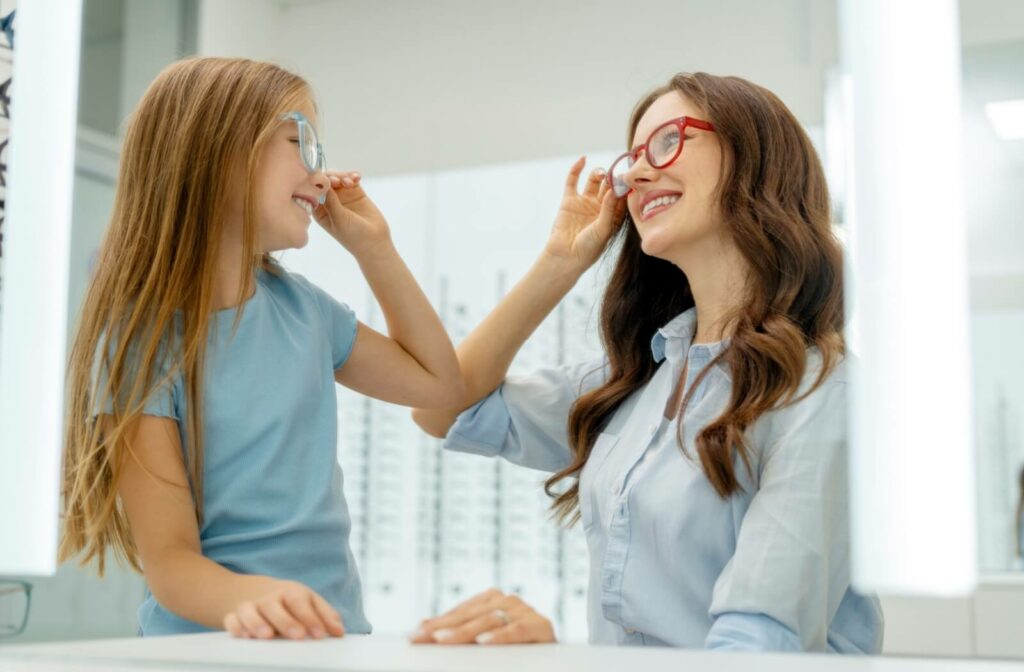Nearsightedness, or myopia, is a common vision issue that makes it hard to see things clearly from a distance, while nearby objects stay sharp. It happens when the shape of the eye causes light to focus in front of the retina instead of directly on it.
Nearsightedness can be corrected with concave lenses. These “minus-powered lenses” work by spreading out light rays before they enter the eye, allowing them to focus correctly on the retina. Your optometrist can determine the right prescription to help correct nearsightedness during a comprehensive eye exam.
What Is Myopia?
Nearsightedness is a refractive error that occurs when the eye is too long or the cornea is too curved. The irregular shape causes light to focus in front of the retina instead of directly on it, causing distant objects to appear blurry while nearby objects remain clear.
How Concave Lenses Work
Concave lenses are thin at the center and thicker at the edges, curving inward. This shape helps to spread out (or diverge) the light rays entering your eye.
By doing so, the lenses move the focal point of the light rays back onto the retina to help correct nearsightedness.
Every lens is customized to the wearer’s prescription. Your prescription will include a diopter value, which measures the degree of nearsightedness.
The more severe your myopia, the stronger the concave lens you’ll need to correct your vision. For instance, a prescription with -3.00 diopters indicates moderate myopia, while a prescription of -6.00 diopters or more suggests a high degree of nearsightedness.

Signs of Nearsightedness in Children
Myopia often begins in childhood, making it essential for parents to recognize the early signs.
Some children don’t even realize they have vision issues because they think it’s normal. Catching nearsightedness early can help make sure your child receives the necessary care to correct their vision and prevent further progression.
Here are some common signs to look out for:
- Squinting: Children with myopia may squint frequently to try and bring distant objects into focus.
- Sitting too close: Whether it’s the TV, a computer screen, or a book, sitting unusually close may indicate difficulty seeing from a distance.
- Complaints of headaches: Uncorrected vision problems can lead to eye strain and frequent headaches.
- Difficulty in school: Trouble seeing the board or difficulty concentrating in the classroom can affect academic performance.
- Excessive eye rubbing: This could indicate discomfort or fatigue from trying to focus.
Managing Myopia Beyond Lenses
Any level of myopia can increase your child’s risk of developing more serious eye issues later in life. While myopia cannot be cured or reversed, regular visits to the eye doctor and following their recommendations can control myopia to correct and protect your child’s vision.
MiSight Contact Lenses
Designed specifically for children, MiSight 1 day contact lenses are easy to use. They correct and slow the progression of myopia. Since they’re daily disposable contact lenses, these contacts are low maintenance, so there’s no need to worry about storage and sterilization habits.
Miyosmart Glasses Lenses
These specialized glasses help correct and slow down myopia progression.
Using specific zones of focus and defocus, your child can see through a focused and an unfocused lens. The focus zones work to correct myopia while the defocus zones control myopia and prevent it from progressing.
Atropine Eye Drops
Atropine eye drops are easily used in addition to contact lenses or glasses. They’re typically used at night to help slow myopia progression. Your optometrist can determine a personalized dosage recommendation for your child, based on their unique needs.
Lifestyle Changes
Research has shown that spending more time outdoors and reducing screen time can help slow the progression of myopia, especially in children. Encouraging outdoor activities and taking regular breaks from digital devices can benefit your overall eye health.
How to Maintain Healthy Vision with Myopia
Correcting nearsightedness is just one part of maintaining your eye health. Regular eye exams, proper eyewear maintenance, and healthy lifestyle habits all play a role in ensuring your vision stays sharp.
Here are a few tips:
- Schedule routine eye exams: Regular check-ups help monitor changes in your vision and adjust your prescription as needed. Annual exams allow you to stay on top of your eye health.
- Protect your eyes: Whether you’re using glasses or contact lenses, it’s essential to keep them clean and in good condition. You should also wear sunglasses to protect your eyes from harmful sun rays.
- Take frequent screen breaks: Digital eye strain can worsen nearsightedness symptoms. Follow the 20-20-20 rule: every 20 minutes, look at something 20 feet away for 20 seconds.
- Stay active: Regular exercise and a healthy diet contribute to overall eye health. Foods rich in vitamins A, C, and E, as well as omega-3 fatty acids, are particularly beneficial.
Myopia Management Starts Here
If you or your child have been squinting to read road signs or struggling to see objects at a distance, it may be time for an eye exam. At Total Focus Optometry, our team offers comprehensive exams for the whole family. We’re here to support your eye health with quality eye care, every step of the way.
Take our quiz to see your child’s for myopia or contact us today to book an appointment and start your journey toward clearer sight.




